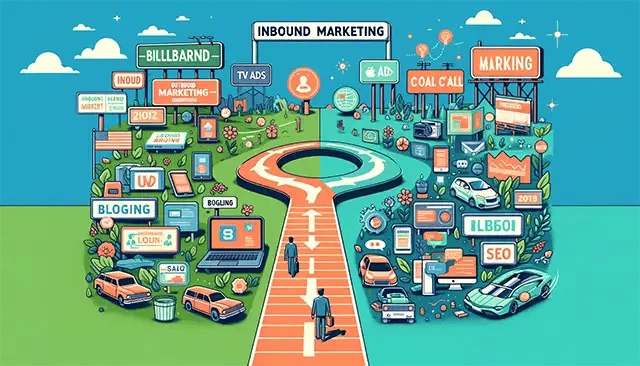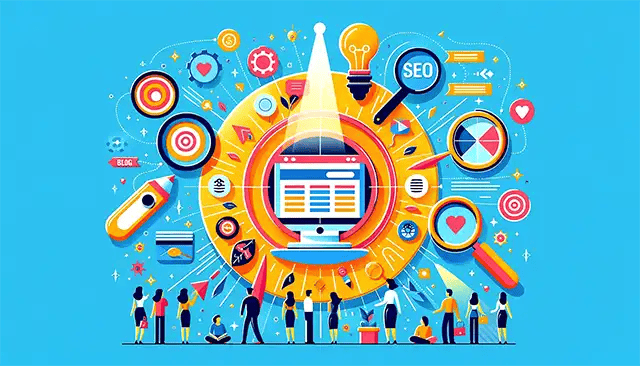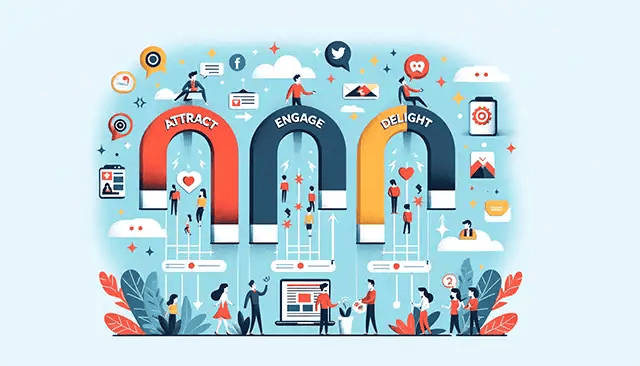Maximizing Growth: Benefits of Inbound Marketing Explained
- Home
- Maximizing Growth: Benefits of Inbound Marketing Explained
Last year, I watched a buddy's start-up struggle to make waves with traditional marketing tactics. They were throwing cash into ads that just got lost in the noise. That's when they pivoted—hard—to inbound marketing.
They began crafting blog posts and videos tailored right to their customer base’s needs and pain points, building trust without shouting over anyone else. And you know what? It worked like magic.
The benefits of inbound marketing became crystal clear: more leads, better conversion rates, lower costs—it was all there. This wasn't about chasing customers; it was about becoming the go-to spot where potential customers came for insights and stayed for solutions.
I'll lay it out straight—by reading on, you're going to get why businesses are flipping their marketing strategy upside down for this customer-centric approach. We’re talking about a way to build trust with increased engagement and sales through valuable content that hits home every time.
Table Of Contents:
- The Shift from Outbound to Inbound Marketing
- Building a Hub for Your Industry with Inbound Marketing
- The Attract-Engage-Delight Model of Inbound Marketing
- Why Inbound Marketing Works Better Today
- Allocating Marketing Efforts Effectively
- FAQs about the Benefits of Inbound Marketing
- Conclusion

The Shift from Outbound to Inbound Marketing
Remember the good old days when billboards and TV ads were the kings of commerce? Well, times have changed. Consumers today are about as enthusiastic about traditional advertising as they are about getting a root canal. Cold calling? Please, that's like trying to get a teenager excited about dial-up internet.
Understanding the Decrease in Outbound Marketing Efficacy
In an age where ad blockers thrive and spam filters catch more than just emails from Nigerian princes, it's no surprise outbound marketing is taking hits left and right. We've all been there—enjoying our favourite show or scrolling through social media only to be ambushed by intrusive ads screaming for attention like toddlers in a toy store.
This resistance has become second nature; 1 out of every 4 internet users arms their browsers with ad blockers, essentially putting up digital 'Do Not Disturb' signs. But can we blame them? The average Joe sees over 5,000 marketing interruptions per day—that’s enough to make anyone crave some peace.
Surely you’ve noticed how your own eyes glaze over during commercial breaks—if you don’t outright skip them thanks to streaming services (admit it.). That instinctual pushback against cold calls? It’s not personal—it’s universal. Over two-thirds of people find unsolicited calls disruptive—even if it might benefit them—and who can argue with wanting uninterrupted dinner time?
Embracing Inbound Marketing for Modern Businesses
Buckle up because here comes an inbound marketing strategy: the superhero swooping in when those interruptive tactics fall flat on their face. By adopting inbound strategies and marketing automation designed around providing value rather than pitching sales at every turn, modern businesses keep pace with savvy consumers who'd rather do anything else than listen to another pitch.
Inbound methodologies treat potential customers like human beings instead of walking wallets—revolutionary stuff. This inbound marketing campaign draws folks in naturally through valuable content tailored just for them—not unlike bees buzzing happily toward flowers offering sweet nectar instead of chasing after fake blooms made out of polyester fabric.
Come on now—who wouldn't prefer being treated as smart individuals capable of making informed decisions without having neon signs flashed before their eyes saying "Buy Now." Adopting this inbound methodology means reimagining business roles too; imagine your sales team engaging leads who want what you’re cooking up because they came looking for information themselves first.
Out with the old, in with the new—billboards and cold calls are out; inbound marketing is in. It's about treating customers like people, not ATMs. Think content that draws folks in because it's what they want to see.

Building a Hub for Your Industry with Inbound Marketing
Your website is not just a digital brochure. It's the epicentre of your marketing universe, especially when it comes to inbound marketing strategies. Imagine transforming it into an industry hub that pulls in potential customers like gravity attracts objects—it’s all about creating that kind of pull by implementing inbound marketing to create content.
Utilizing Search Engines to Attract Visitors
The art and science of making your website visible on search engines are akin to setting up a neon sign on the busiest street in town—except this street is digital, and the traffic never sleeps. With smart SEO tactics, you can ensure your site pops up when people look for solutions you offer. This isn't just about cramming keywords onto web pages and attracting customers; it's about crafting a great customer experience by creating content that genuinely speaks to their needs.
We've seen businesses double their site traffic by implementing these techniques effectively to create inbound marketing content—an impressive stat worth noting from our recent findings. By focusing on long-tail keywords related to your niche and providing relevant answers through blog posts or detailed service descriptions, you'll likely see increased visits from interested parties who are more than window shoppers—they're ready buyers.
Blogging for Credibility and Brand Awareness
Credibility doesn’t come overnight; it’s earned one insightful blog post at a time. When done right, blogging positions you as the go-to expert within your field—the wise sage if we’re being dramatic—and what business doesn’t want that reputation? Engaging blogs not only showcase expertise but also gives lifeblood to brand awareness campaigns by bringing forth unique perspectives or untold stories from within the industry trenches.
Think of each post as an invitation into your world where visitors become familiar faces over time because they resonate with what they read. And let me tell ya’, familiarity breeds trust which eventually leads seven times out of ten (yep, another fun fact) towards choosing YOUR solution over competitors’ offerings due largely thanks simply knowing YOU better through valuable content shared regularly online.
Turn your website into an industry magnet by making it a hub by implementing inbound marketing strategies. It's like gravity for potential customers.
Get seen on search engines with smart SEO that speaks to real needs, not just keyword stuffing—watch traffic and ready buyers soar.
Blogging is the long game for credibility. Become the expert everyone trusts, one post at a time—and watch as familiarity turns readers into customers.

The Attract-Engage-Delight Model of Inbound Marketing
Developing a Strong Content Strategy
In the realm of inbound marketing, your content is king. But not just any scribble on the wall; we're talking about high-quality content that hits home with your target audience. Crafting this kind of engaging material isn't like throwing spaghetti at the wall to see what sticks—it's an art form and science combined.
To make it work, you've got to dig deep into understanding who's out there looking for you. Once you get a grip on their needs and pain points, start creating valuable content that provides the answers they're searching for—not just noise in their already cluttered feeds. And remember, when building trust with potential customers, consistency is key. That blog post or eBook should be part of a well-oiled machine within your marketing campaign—reliable as clockwork.
With 9 out of 10 organizations using content marketing tactics according to the latest figures from the Content Marketing Institute, standing out means crafting personalized content so laser-focused that it feels like it was made only for them—because it was.
Social Media and Ads for Awareness
Gone are the days when ads felt like someone threw darts blindfolded hoping something would hit its mark—a modern marketer knows better than relying solely on interruptive tactics. Instead, leveraging social media platforms lets us waltz right into our audience’s daily lives (with permission), giving us centre stage without feeling invasive.
We don’t just barge in though—we come bearing gifts: posts, videos, and articles brimming with relevance making sure every interaction adds value rather than subtracts attention spans. Social ads aren't mere billboards anymore. They're more like magnets drawing customers closer by aligning perfectly with their interests, ensuring increased conversion rates are no longer wishful thinking but expected outcomes.
If you think traditional outbound methods still cut the mustard in driving sales, let me drop some knowledge – research indicates businesses implementing inbound strategies have seen up to a 200% increase in engagement. Now if those numbers don’t make you want to hop aboard the train with a customer-centric strategy, I’m not sure what will.
Nurturing Leads Through Email Marketing and Chatbots
Email might seem old school next to shiny new tech toys, but here’s the thing - its effectiveness endures precisely because it feels personal. Nurturing leads through email isn’t spamming an inbox. It sends tailored messages designed to guide potential customers on a journey that aligns with their needs and interests, fostering a connection that could lead to lasting loyalty.
To win at inbound marketing, think of your content as a VIP guest—make it so good that it not only gets through the door but also becomes the life of the party. Dive deep to understand your audience and create killer content they can't ignore.
Forget spray-and-pray ads; today's top marketers craft social media posts like personalized gifts that magnetize audiences. And despite its age, email remains king for nurturing leads with messages that feel more like handshakes than sales pitches.

Why Inbound Marketing Works Better Today
Gone are the days when businesses could rely solely on traditional outbound marketing efforts to encourage customers to sign up. The digital landscape has evolved, and so have the preferences of consumers, making inbound marketing a heavyweight champ in attracting paying customers.
Lower Costs with Online Learning and Shopping
The cost-effectiveness of online learning resources compared to conventional seminars is like night and day. Consider this: instead of spending big bucks booking venues for trade shows or workshops, companies can now use webinars and e-courses to educate their customer base at a fraction of the price. These methods of building customer relationships not only save you some green but also allow your audience to learn at their own pace from a trusted authority—a win-win situation.
Moreover, think about shopping online versus brick-and-mortar stores—the difference in overhead costs is staggering. An inbound approach takes advantage of this shift by providing valuable content that leads users down the buyer's journey without ever needing them to step foot outside their door. And let’s be real; who doesn’t love shopping in pyjamas?
Engaging Qualified Prospects Online
Drawing customers into your world now means engaging them where they spend most of their time—online. By creating relevant content tailored just for them (think blog posts videos), we're speaking directly to our target audience's pain points. This isn't casting a wide net over an uninterested crowd; it's more like using a magnet specifically designed for those who are already looking for solutions you offer.
Inbound tactics aren't just clever—they’re smart business moves that boost conversions significantly, ultimately driving traffic, because people engaged through these methods often arrive pre-qualified as potential leads ready to go from "just browsing" straight into "shut up and take my money." mode.
Allocating Marketing Efforts Effectively
Budget
The secret sauce to marketing success isn't just creativity; it's also about where you put your money. Imagine this: You've got a dollar, right? Now, think of that dollar as your trusty steed in the race towards customer satisfaction and brand growth. Allocating marketing efforts efficiently means betting on the horse with the best odds using an inbound marketing approach.
It’s no longer a hidden fact that efficiency in marketing comes from strategic investment. Studies have shown that inbound tactics can slash costs by over 60% per lead compared to traditional outbound methods. That's like opting for an electric car instead of guzzling gas – smart and cost-effective.
Now, let's get real about what counts—ROI (return on investment). With every greenback aimed at inbound strategies such as SEO or content creation, companies are seeing higher conversion rates skyrocketing past those achieved through conventional advertising punches like cold calling or interruptive ads. We're talking about increased conversion rates up to six times more than old-school approaches.
Focusing Your Financials Where It Matters Most
You wouldn’t throw seeds into a windstorm hoping they'll grow somewhere fruitful; so why scatter your budget across outdated channels? Efficiency is key here - align funds with tactics proven to draw in paying customers who want what you’re selling.
We’ve all been there before—you click on something interesting only to be met with disappointment because it wasn’t quite what you were looking for. In contrast, when allocating resources toward creating valuable content tailored for specific search engine queries, businesses help ensure users find exactly what they need—when they need it—which naturally encourages them down the buyer’s journey path straight into sales territory.
A penny saved may be a penny earned but invest those pennies wisely into inbound techniques such as targeted blog posts or engaging social media campaigns and watch how quickly those coins multiply—as if by magic. Budget allocation within these realms supports not just one-off purchases but fosters ongoing relationships between brands and consumers alike—a long-term gain far outweighing short-lived flash-in-the-pan sales spikes common with traditional outbound flares.
Making Every Cent Count Through Targeted Approaches
Digging deeper, let's look at some compelling numbers:
- An estimated 61% of marketers rank improving SEO and growing their organic presence as their top inbound marketing priority.
- Many organizations find that inbound strategies are more cost-effective than traditional outbound methods, with about three-quarters reporting significant savings.
Think of your marketing budget as a smart bet. Inbound tactics like SEO and content creation not only cut costs but also ramp up conversions, giving you more bang for your buck.
Betting on inbound is like investing in an electric car – it's efficient and saves money over time. Aligning funds with these proven strategies can turn pennies into profits.
FAQs about the Benefits of Inbound Marketing
What are the advantages of inbound?
Inbound marketing magnetizes your audience, building trust and establishing relationships by aligning content with customer interests.
Why is inbound marketing more effective?
Inbound marketing helps draw in folks actively hunting for solutions you offer, leading to higher engagement and conversions.
What is the value of inbound marketing?
Inbound delivers lasting results by nurturing prospects into loyal fans who advocate for your brand organically.
Why would a company use inbound marketing?
A company leans on inbound to connect with customers on their turf, offering value first and selling second.
Conclusion
So, here's the scoop. The benefits of inbound marketing are transforming businesses left and right. It's about pulling in folks who want to hear from you, rather than pestering those who don't.
Dive into this approach and you'll see your brand become a beacon for your target audience. You've learned that creating engaging content isn’t just smart; it’s necessary.
Remember how we said outbound is out? Well, making friends with search engines through stellar blog posts proves just why. And when it comes to nurturing relationships, nothing beats personalized emails or clever chatbots.
In short: Inbound means growth without the grind. Outbound marketing relies on interrupting users. Engage sincerely, delight consistently and watch as visitors turn into loyal customers—naturally.
Author Bio: Clwyd Probert CEO & Founder, Whitehat Inbound Marketing Agency
Clwyd Probert is the CEO and founder of Whitehat, a Diamond HubSpot Partner agency in London. With over two decades of experience, Clwyd has established himself as an expert in inbound marketing and lead generation. His career spans the creation and growth of multiple businesses in the UK and the USA, blending his knowledge in science and technology with innovative marketing strategies. Apart from his professional pursuits, Clwyd is an active philanthropist involved in animal welfare initiatives. He holds an MSc in Computer Science from UCL and a BSc in Molecular Genetics from Aberdeen University.


